30.09.2004
M.Dvoretsky. Positional sacrifice of the Queen
In the summer of 1991 I gave a few lessons to a group of American juniors, and then all of us joined a large traditional tournament "World open ". In the first round one of my students, 15-years old Bobby Seltzer played with a grand master.
Seltzer - Giorgadze
Philadelphia 1991
1.e4 e5 2. ¤f3 ¤c6 3. Ґb5 g6 4.0-0 Ґg7 5.c3 a6 6. Ґa4 d6 7.d4 Ґd7 8. Ґg5 f6 9. Ґe3 ¤h6 10.de!?
Though the young chess player didn`t know the theory, he managed to show a sensible interpretation of the position and soon afterwards he gained an advantage (certainly, not without help of the opponent). In the 14th game of the world championship Bogoliubov - Alekhine (Germany/Netherlands 1929) it was played 10.h3 ¤f7 11. ¤bd2 0-0 =.
10.. de
10. fe 11. Ґg5, and 10. ¤:e5!? Can also be found.
11. Јd5 Јe7 12. Ґc5 Јf7 13. ¤a3 0-0-0
The ending of the Black is good enough 13. Ј:d5 14.ed ¤e7.
14. Јd3 f5?!
The grand master tries to confuse the partner, but as a result he got confused himself. After 14. ¤b4 15.cb Ґ:a4 16. Јc3 Ґc6 white could either protect a pawn: 17. ¦fe1 or aggravate the game by 17.b5!?. 14. Ґe6!? 15. Јe2 ¤b8 is more reliable with mutual chances.
15. Јe2 fe 16. ¤g5 Јd5 17.b4 Јd3 18. Јb2
There is a danger of 19. ¦d1, White will make a move b4-b5 as soon as possible.
18.. ¤b8!?
A psychological trap!

19. ¦a1-d1?
Almost any "normal" move would keep a considerable advantage: 19. Ґc2 Јe2 20. ¤:e4; 19. Ґb3; 19.b5.
19.... Ґd7:a4!
This was obviously unexpected for White. Obviously, Bobby did not come across such kind of positional sacrifices before, for this reason he didn`t take into account the respond of the opponent, thus having proved once again a felicitous remark of Aron Nimzowitsch: «A chess player would rather put his head into the lion`s mouth, than lay a Queen open to attack. "
20. ¦d1:d3 e4:d3
For the sacrificed Queen Black received a rook, a bishop and a strong passed pawn. His chances in a forthcoming struggle are not worse, at least. Besides, White had turned out to be not ready psychologically for the drastic change of the situation and having made a number of inaccurate moves he got a lost position in a short time.
21. ¤e4?!
21. ¤e6? d2! did not work, but he shouldn`t have hurried with moving back the ўnight because the black ўnight still could not be moved because of the fork ¤f7. 21. ¤c4 is more preferable.
21.. ¤f5 22. ¤c4 Ґb5 23. Јb3 ¦he8 24.a4 Ґc6 25. ¤cd2?! [25.f3] 25. b6 26. Ґe3 ¤:e3 27.fe Ґh6 28. ¦e1 [28. ¦f3!?] 28. Ґ:e4 29. ¤:e4 d2 30. ¦d1 ¦d3 31.h4 ¦ed8 32. ¤g5 Ґ:g5 33.hg ¦:e3P 34. ўf2 ¦ed3 35. ўe2 b5 36. Јe6 + ўb7 37.ab ab 38.c4?! ¤c6 39. Јf7 e4 40. ¦:d2 ¦:d2 + 41. ўe3 ¦8d3 + 42. ў:e4 ¦e2 + White resigned.
When the game had been over, I analyzed it with Bobby Seltzer, afterwards I showed him a similar situation in my old game against Albert ўapengut. In a few days we had the reason to return to the same subject again. In the sixth round I crossed swords with an opponent, with whm I had played many times in the Soviet championships (after the tense struggle all the previous duels were drawn).
Dzidzichashvili - Dvoretsky
Philadelphia 1991
1.e4 e6 2.d3 c5 3. ¤f3 ¤c6 4.g3 g6 5. Ґg2 Ґg7 6.0-0 ¤ge7 7. ¦e1 d6 8.c3 e5!? 9.a3
d3-d4 is not easy for White: 9. Ґe3 0-0 10.d4?! ed 11.cd d5! [after 11. Ґg4!? 12.dc should be taken into consideration]. Therefore they start playing on Queen side.
9.. 0-0
There is no sense to hamper b2-b4 by 9. a5?! – A king`s Indian defense pattern which is favourable for White appears after 10.a4.
10.b4 h6 11.bc?
An infelicitous idea for the following move. Normal continuation: 11. ¤bd2 Ґe6 12. ¦b1 or 12. Ґb2. By the way, a little bit before, in the 3rd round of the same tournament there was a game Fang - Dvoretsky in which 12. Ґb2 Јd7 13.d4 was played?! [13. Јe2!? ¦ae8 14. Јf1 Dominguez - Dvoretsky, Terrassa 1996; 13. ¤b3!?] 13. ed 14.cd cb 15. Јb1 [15.ab ¤:b4 with threats 16. ¤d3 or 16. d5] 15. ba 16. ¦:a3 d5 with the advantage of Black.
11.. dc 12.c4
White wants to move the ўnight on d5. In case of 12. Ґg4 13.h3 Ґ:f3 14. Ґ:f3 ¤d4 15. Ґg2 his position is more preferable, as the diagonal for white square Bishop opens after 15. f5, otherwise, there is no clear plan for Black, while the next moves of White are obvious: ¤c3, next ¤d5 or a3-a4-a5.
12.. f5!
An unpleasant surprise: the pawn moves to f4 to attack the King side. It`s impossible to prevent this: 13.ef? e4R.
13. ¤c3 f4 14. ¤d5 g5 15.h3
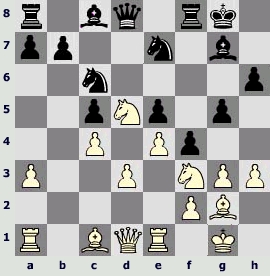
15.. g4!
When the game was over Roman Dzindzichashvili asked, why I had not played 15. ¤g6.
- I was confused with respond 16.g4.
- It is too passive; I would never make such a move.
- Why haven`t you warned me? Then `, certainly, would have moved the Knight on g6.
The position of White is strong though it`s passive after 15. ¤g6 16.g4. It is important, that Black can not easily prepare for h6-h5. I guess that I was right having decided for a sharper continuation.
16. ¤h4!?
In case of 16.hg Ґ:g4 the Knight`s pin is rather unpleasant, it`s not easy for White to defend. Therefore they sacrifice a pawn, 16. gh 17. Ґf3 in the hope of exchanging the white square Bishops by Ґg4 and getting white squares under control. Perhaps I was wrong "to take on trust" what my opponent said. Because after 17. ¤d4 the respond 18. Ґg4 is hardly possible because of 18. ¤:d5 19.cd Ґ:g4 20. Ј:g4 ¤c2, and if 21. Ґb2, then 21. fg! P. However, in a variant 18. Ґh5 ¤:d5 19.cd with the following 20. ¦a2 (b1) the position was still rather difficult.
I had a different plan: I planned to make a move f4-f3 at a well-chosen moment, to get the opponent`s white square Bishop out of the game.
16.. h5 17. Ґb2
I expected 17. ¦b1!? Јd6N. A move that takes the Bishop away from the important diagonal c1-h6 seems to help Black to fulfill their plan.
17.. f3 18. Ґf1 Јd6
18. Ґh6? Is too early because of 19. ¤:e7 + ¤:e7 [19. Ј:e7 20. ¤g6] 20. Ґ:e5, but now Black wants to move Bishop on h6. I expected 19. Ґc1, with variant 19... Ґh6 20. Ґe3 (planning 21. Јd2) 20. Ґ:e3P. Actually the respond 19. Ґh6? is not good because of the striking blow 20.d4!! ±; therefore 19. ¤:d5 20.ed ¤d4 which maintain the advantage are correct.
White had as well at his disposal the a sharp attempt 19.d4!?. In all variants there were non-standard situations in which White would probably get a quite good compensating for the sacrificed material. For example, 19. cd 20.c5 Ј:c5 21. ¤c7 ¦b8 22.hg Ґ:g4 23. Јb3 + ўh7 24. ¤e6 Ґ:e6 25. Ј:e6і. Or 19. ed 20.e5 Ґ:e5 [20. ¤:e5!? 21. ¤:e7 + Ј:e7 22. ¤g6 Јd6 23. ¤:f8 Ј:f8N] 21. Јd2 Ґg7 22. Јg5 [22. ¤:e7 +!? ¤:e7 23. Јg5і] 22. ¤:d5 23.cd ¤e5 24. Ґc1і.
Dzindzichashvili had found another, absolutely unexpected idea which involves a positional sacrifice of the Queen in return for two light pieces.
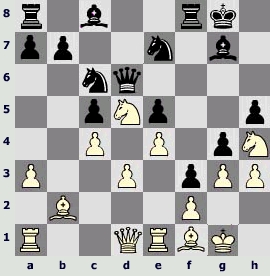
19. Јd1-d2!!
At first sight this is a strange move because Black wanted to move the Bishop on h6, and now it`s impossible to do this with tempo. However, immediate 19. Ґh6? will be met by 20. ¤:e7 + ¤:e7 21. Ґ:e5! Ј:e5 22. Ј:h6. And as Black is under the threat of the opponent`s Queen to move on g5, he can not be slow to act.
19.... ¤e7:d5
20.e4:d5 Ґg7-h6
Јf 21. Јc2, then 21. ¤d4 22. Ґ:d4 ed with following Ґd7, and Black has obvious advantage – he got two opponent`s pieces(a white square Bishop and a Knight h4) out of game at once.
21. Јd2:h6! Јd6:h6
22.d5:c6
Fortunately I had already had an experience of playing the same positions and I knew, what energy can have two co-operative pieces of the opponent, for example, after 22. bc?! 23. ¦:e5. Therefore the following move which prevented the Rook from moving on е5, was made promptly.
22.... ¦f8-e8!
Now white should have moved either 23.cb Ґ:b7 24. ¦:e5, or 23. ¦:e5 at once. Probably, Black had the chances but it would have been not so easy for him to use his material advantage.
But the opponent who had lost his nerves and conceived a mad idea has strongly helped.
23.c6-c7? Јh6-d6
24. ¦e1-e3 Јd6:c7
25. ¤h4-g6??
After 25. ¦ae1 it was possible to decide between 25. Јa5!? 26. ¦:e5? Ј:e1° [or 26. ¦:e5 27. ¦:e5 Јd2°] and 25. Јb6 26. Ґ:e5 Ґd7µ.
25.... Јc7-b6!
A decisive double attack. White resigned
I have already analyzed the above mentioned game against Kapengut in the book "School of Chess Excellence 2 - Tactical Play ". I shall repeat my comments from the book for those who didn`t read it.
Kapengut - Dvoretsky
Cup of the USSR, Ordzhonikidze 1978
1.е2-е4 с7-с5
2. ¤g1-f3 е7-е6
3.d2-d4 с5:d4
4. ¤f3:d4 ¤g8-f6
5. ¤b1-с3 ¤b8-с6
6. ¤d4:с6 b7:с6
7.е4-е5 ¤f6-d5
8. ¤с3-е4 Јd8-с7
9.f2-f4 Јс7-b6
10. Ґf1-d3
At the moment when the game was played, Black decided for 8. f5 more often, variant 8... Јс7 9.f4 Јb6 had not been in fashion yet. Later the main continuation of White became 10.с4!? Ґb4 + 11. ўе2!.
10.... Ґс8-а6
11.а2-а3
In case of 11.с4 White loses a pawn: 11. Јb4 +! 12. Ґd2 Ј:b2.
11.... f7-f5?
A mistake which brings Black to a difficult position. 11. Ґе7 should have been played, getting ready a counterattack 12. f5! for 12.с4.
12.е5:f6 ¤d5:f6
13. ¤е4:f6+ g7:f6
14. Јd1-h5+ ўе8-d8

Black has to take into consideration Јf7, but it is too early to make it before the development is completed. After 15. Јf7? comes 15. Ґ:d3! 16. Ј:f6 + [16.сd f5 or 16. Јd4] 16. ўс7 17.сd Ґс5 or 17. ¦g8, and Black gets an excellent compensation for the lost pawn.
A simple exchange: 15. Ґ:а6! Ј:а6 16. Ґd2 would provide an advantage. d7 is very weak; White plans 0-0-0, Ґс3 (or Ґа5 +), Јf7 in this or that order. Ј don`t know at all what I would have done then. After 16. Јb5 comes not 17. Ґа5 +? ўе7 18. Ґb4 + ўd8 with equality, but 17. Јf7 Ґе7 [17. Ј:b2 18. ¦d1 or 18. Ґа5 +] 18.0-0-0.
Fortunately, the opponent was tempted by other attractive opportunity.
15. Ґс1-d2?
White hopes to win tempo threatening 16. Ґа5.
15.... Ґа6:d3!!
It is necessary to mention, that I was in bad condition in the beginning of the competition. This could be seen chiefly in the opening. By the tenth move of the first round my position was absolutely hopeless, but afterwards I had beaten the opponent. In the second round I had White and by the end of the opening my position was of no doubt worse than that of the opponent, but finally I had almost managed to win the ending. And the third round came...
As soon as I had made a move I rose from the table and I heard a member of our team "Petrel" Yuri Razuvaev speaking to the coach: "Well, Mark is not up to it at all, he has just overlooked the Queen". I had to calm them down: "May be you are right and I`m not up to it but I didn`t overlook the Queen, I sacrificed it!"
In addition to obvious shortcomings, you can benefit from a long tournament practice break. You feel the taste to game, a fresh vision of a position, a desire to risk, to sacrifice. Despite all opening difficulties which I had almost in each round, as a result I managed to win four games, to draw three games and to have the best result not only at my chess board but also among all man`s boards.
16. Ґd2-а5
After 16.сd a terrible file "d" is closed, White doesn`t have anything.
16.... Ґd3:с2
The position became vague. The black Queen is sheltered only by two Bishops and a pawn, but these pieces will soon start to cooperate with each other and will take many important squares under control. Heavy pieces of White have no place to expand.
17. ¦h1-f1
17. Ґ:b6 + аb 18. Јh4, suggested itself attacking f6 and threatening with double attack 19. Јf2. But the Bishop solved all problems of Black: 18. Ґе7 19. Јf2 Ґb4 +! 20. ўе2 Ґс5.
17.... f6-f5
17.. ўс7!?.
18. Ґа5:b6+ а7:b6
19. ¦f1-f3
Probably 19. ўd2 is stronger with following ¦ае1.
19.... ўd8-с7
20. ¦f3-g3 ¦а8-а4
20. Ґd6 is more reliable, being not afraid of 21. ¦g7 Ґ:f4 22. Јf7 ¦аd8.
21. Јh5-f3?!
21. Јf7; 21. ¦с1.
21.... ¦а4-с4!
It is necessary to parry a threat 22. Јс3. 21. Ґb4 + would have been much worse because of 22.аb! ¦:а1 + 23. ўd2.
22. ¦а1-с1?
After that the initiative finally passes on to Black. 22. Је2 ¦е4 23. ¦е3 is stronger with unclear game; 22.b3 ¦с5 23.b4 ¦с4 could optionally be made first.
22.... Ґf8-d6
23. Јf3-е2 ¦с4-е4
23. Ґd3 was not bad as after 24. ¦:с4 Ґ:е2 25. ў:е2 b5 the pawn f4 was lost.
24. ¦с1:с2
Kapengut decides to return the Queen. 24. ¦е3 Ґ:f4 25. ¦:е4 Ґ:е4 26. ¦с3 Ґ:h2 27.g3 Ґg1 are even less attractive.
24.... Ґd6:f4
25. ¦g3-g7 Ґf4:h2
25. ¦:е2 + 26. ¦:е2 are weaker, and a pawn е6 is endangered.
26. Је2:е4 f5:е4
27. ¦с2-d2 Ґh2-d6
28. ¦d2-d4 с6-с5!
29. ¦d4:е4 ўс7-с6

Black has two pawns for quality. Јt`s clear, that my opponent should struggle for a drawn game.
30.b2-b3 h7-h5
31. ¦е4-h4 b6-b5
32. ўе1-е2 Ґd6-е5
32. ¦а8!? 33.а4 Ґе5! Are also worthy of notice [33. bа 34. ¦:а4 are worse] 34.аb + ўd6 35. ¦h7 ¦а2 +.
33. ¦g7-g5 Ґе5-d4
34. ¦h4:h5
34.b4 ¦а8 35. ¦g3 are more preferable.
34.... ¦h8-а8
35. ¦h5-h3 ¦а8:а3
36. ¦g5-g8 е6-е5
37.g2-g4 ¦а3-а2 +
37.. е4!?.
38. ўе2-f3 ¦а2-f2 +
39. ўf3-g3 ¦f2-b2
40.g4-g5
40. ўh4 is more persistent.
40.... ¦b2:b3 +
41. ўg3-g4 ¦b3:h3
42. ўg4:h3 ўс6-d5
43.g5-g6 е5-е4
44. ¦g8-b8 b5-b4
45. ўh3-g4 ўd5-с4
White resigned.
After the game my opponent was started on: It turned out that one could concede a Queen to him. "I tell them, that the position was unclear, but they don`t believe me", - Kapengut was complaining to me during the supper. I could only sympathize with him. Really, it is not easy to go deeply in a substance of the game, to notice and understand those problems, which the players had to solve, just watching from the outside.
I was greeted with applause when in the evening I entered a room where participants of our team (masters and grandmasters) had gathered. Probably, the sacrifice of the strongest chess piece warms the cockles not only of amateurs` hearts, but also of experienced professionals`.
The only difficult thing for Black is to take into account such a possibility. A psychological prejudice noticed by Nimzowitsch stands in the way of a chess player ("A chess player would rather put his head into the lion`s mouth, than lay a Queen open to attack.") As soon as a sacrifice of the Queen comes into the view it becomes clear that this is a right way to play. It is not even necessary to speak about risk. Because during an "ordinary" game the position of Black is difficult, and after a sacrifice the situation goes out of control of both players, so any result of a game is possible.
As well as two analyzed above games, the following selection basically includes the examples of positional sacrifice of the Queen for two light pieces.
Gelfand – Adams
6th game of the elimination match, Wijk-an-Zee 1994 (on the basis of the comments of Boris Gelfand and Alexander Huzman)
1.d2-d4 d7-d6
2.e2-e4 ¤g8-f6
3.f2-f3 d6-d5!?
4.e4-e5 ¤f6-d7
5.f3-f4 c7-c5
6.¤g1-f3 ¤b8-c6
7.Ґc1-e3
In contrast to the famous positions of the French defense Black hasn't played e7-e6 yet, and White hasn't decided whether to put at c3 a pawn or a Knight. Michael Adams certainly could narrow the matter down to "theory", having chosen either 7...e6, or 7...Јb6 8.¤c3 e6, but he preferred another course of the game.
7. . . . c5:d4
8.¤f3:d4 ¤c6:d4
9.¥e3:d4 ¤d7-b8
10.¤b1-c3 ¤b8-c6
11.Ґf1-b5!?
White is striving to keep the Bishop at d4, and for this he is ready to exchange the other Bishop. It's an interesting, but controversial plan, because simple 11.Ґf2 e6 12.Ґd3 could provide him an excellent playing.
11. . . . e7-e6
Black failed to take advantage of the absence of the pawn at е6 – in case of 11...Ґf5 12.g4 Bishop would have to come back to d7.
12.a2-a3!?
Gelfand rejected 12.0-0 Ґd7 13.f5 because of the response 13...Јh4!?, that didn't allow the white Queen to come out to g4 or h5.
For 12.Јd2 Gelfand and Huzman pointed out the variant 12...Јa5 13.a3 Ґd7 14.Ґ:c6 bc 15.0-0 c5 16.b4 Јc7! 17.bc Ґ:c5 18.¦f3 with unclear play. In their opinion 16...cb 17.ab Ј:b4 18.¦fb1 is losing – but this is not quite obvious: Black responds by 18...Јc4, planning 19...Ґc5, and 19.¦:a7 ¦:a7 20.¦b8+ Ґc8 21.Ґ:a7 Ґc5+ 22.Ґ:c5 Ј:c5+ 23.ўh1 0-0 doesn't promise an advantage to White.
12. . . . Ґc8-d7
In the variant 12...Ґe7?! 13.Јd2 0-0 14.Ґ:c6 bc 15.¤a4± White set the control over the square с5.
13.Ґb5:c6

It was certainly possible to play 13.Ґf2 a6 14.Ґd3, but then it is not clear why the Bishop was moved at b5. The move in the game caused not a simple problem for Black: he has not decided which piece should capture c6.
13. . . . Ґd7:c6?
Adams is an excellent chess player, but he frequently loses his bearings in critical situations, he is not very confident in solving problems concerning tactics, sacrifices, estimation of difficult variants. This drawback came out several times in the given game.
Obviously Adams declined 13...bc! because of 14.¤a4 Јa5+ 15.c3. Having played b2-b4 White is going to block black pawns and capture с5 that will provide an advantage to him. To 15...c5 he prepared 16.¤:c5 Ґ:c5 17.b4, and after 17...Ґ:b4 18.ab his advantage is beyond any doubts – the Bishop d4 is far stronger than that of the opponent.
The English GM didn't take into consideration or underestimated the sacrifice of the Queen for two light pieces: 17...Ґ:d4! 18.ba Ґ:c3+ 19.ўf2 0-0! [but not 19...Ґ:a1? 20.Ј:a1± – to get control over black squares is more important than to regain a part of the sacrificed material] 20.¦c1 Ґ:a5 with subsequent f7-f6.

In the upcoming struggle Black has not less chances than the opponent. His pieces are able to develop a high activity, while White has nothing to attack.
14.0-0
Here the advantage is on the side of White, the opponent is deprived of a counter-play. An importance of the Bishop d4 is noteworthy: it blocks the central pawn, hampers the disruption f7-f6, and the main thing, maintains the activity of White at both wings. There is already the danger of 15.f5, and this break-through will be constantly in the air, even if for now it's possible to guard against it. And at the Queen side a bead is drawn on the pawn a7, the advance of the white pawn "a" looks promising.
14. . . . g7-g6
15.£d1-d2 £d8-c7
16.¦f1-f3 b7-b6
17.¤c3-d1! h7-h5
To 17...Ґc5 White responses 18.¦c3! Ґ:d4+ 19.Ј:d4±.
18.a3-a4! Ґf8-c5
The move 18...a5 weakens the pawn b6 (19.Јf2).
19.¦f3-c3 ¥c5-e7
20.b2-b4!? £c7-b7
20...Ґ:b4? 21.¦:c6 Ј:c6 22.Ј:b4 is rather bad.
21.¦c3-b3 ¥c6-d7
22.¤d1-e3 ¦a8-c8
22...a6 would be followed by 23.f5!.
Now the position of White is good enough to attack any wing. it's important to make a wise choice.

23.f5! led to the overwhelming advantage. 23...gf 24.¤:f5 ef 25.e6 ¦g8 26.ed+ Ј:d7 27.¦f1 is hopeless, and in case of 23...Ґg5 White has a pleasant choice between 24.f6!? and 24.fg fg 25.Јd3 ўf7 26.c4!.
23.a4-a5?!
Also looks strong. 24.abab 25.¦ba3 is threatening; both 23...ba 24.¦:a5 and 23...b5 24.a6!? are cheerless (or immediately 24.f5). However Adams finds a way to barricade the Queen side.
23. . . . ¥d7-b5!
24.a5:b6 a7-a6!
White must take measures against 25...Ґd8 and 26...Ґ:b6.
25.¦b3-c3
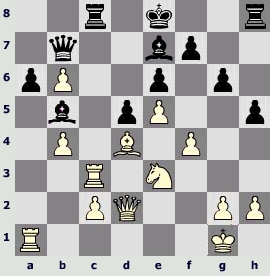
It's the next problem for Black concerned with calculation of variants and positional sacrifices (an exchange this time), and again Adams failed to solve it.
It was necessary to exchange the Rooks straight away: 25...¦:c3! 26.Ј:c3 ўd7!. The King should be kept in the centre, because after 26...0-0? 27.g4 it gets under a strong attack.
Alexander Riazantsev suggested 26...Ґd8 with such variants: 27.Ґc5 Ґ:b6 28.Јd4 Ґ:c5!? 29.Ј:c5 Јe7 30.Јc8+ Јd8 with equality, or 27.Јc5 Ґe7 28.Јc7 Ј:c7 29.bc ўd7 30.Ґb6 Ґ:b4 31.c4 ўc6! With an uncertain position. The play of White is successively strengthened by means of 30.¤:d5! (instead of 30.Ґb6) 30...ed 31.e6+ fe 32.Ґ:h8 Ґ:b4 33.Ґe5 Ґc5+ 34.ўh1 Ґb6, and now either 35.¦a3, or 35.¦e1, or 35.g4 with a good chance to win.
27.Ґc5 [27.Јd2 ¦c8„] 27...¦c8 [27...¦b8? 28.Јd4 Ґd8 29.c4 Ґc6 30.b5 is bad] 28.Јd4 (the danger of 29.c4), and now not 28...ўe8? 29.g4 Ґd8 30.gh gh 31.ўf2 with subsequent 32.¦g1, but 28...¦:c5!! 29.bc Јc6.
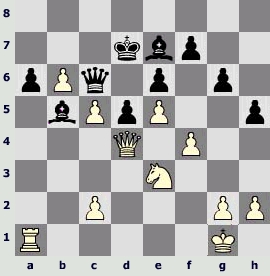
The move 30.c4 isn't dangerous now – Black responses either 30...Ґ:c4 31.b7 ўc7 32.Јb2 Ґb5, or 30...Ґ:c5 31.cb Ј:b6. If 30.b7, then 30...ўc7! with mutual chances [but certainly not 30...Ґ:c5? 31.b8¤+]. Finally 30.ўh1 is met by 30...Ґ:c5 31.Јd2 Ј:b6, and everything is all right for Black.
25. . . . ¢e8-d7?
26.¦c3-c5!
Adams obviously underestimated this sacrifice of the exchange, threatening terribly 27.c4. After 26...Ґ:c5 both 27.Ґ:c5 and 27.bc are possible.
26. . . . ¦c8:c5
27.b4:c5?!
27.Ґ:c5 is simpler and stronger, with the won position.
27. . . . ¦h8-c8
28.c2-c4 d5:c4
Black must keep the white-square Bishop to block passed pawns of the opponent. 28...Ґ:c4 29.¤:c4 dc 30.Ґf2+ ўe8 [30...Јd5 31.Јc2 ўe8 32.Јa4+] 31.Јb4 are quite hopeless.
29.¦a1-c1 ¢d7-e8
30.¤e3:c4 £b7-d5
31.¤c4-a5
31.¤d6+ Ґ:d6 32.ed Ґc6 are worse.

31. . . . ¥b5-c6?
Now the white-square Bishop is being exchanged and the blocking of the passed pawns turns out to be fragile. And meanwhile Black had at his disposal the last attempt to pose problems for the opponent: 31...¦:c5! [31...Ґ:c5? wasn't good as 32.¦:c5! ¦:c5 33.b7].
It may seem that this move can be rebutted by 32.b7 ¦:c1+ 33.Ј:c1 Ј:d4+ 34.ўh1. However let's go on with the variant: 34...Јb6! 35.Јc8+ Ґd8 36.b8ЈЈ:a5.
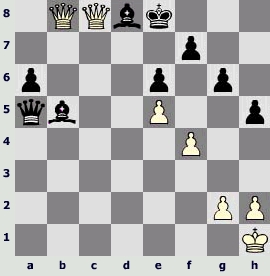
It's the second time in this game, when we come across the situation with the Queen against two Bishops, and again light pieces are able to withstand the Queen successively. White certainly will try to play for a win, but it's quite unclear, how he will manage to break through the opponent's defense both in the case of three Queens and in the case of exchange of a pair of Queens.
It's fair to note that White nevertheless kept a great advantage, continuing 32.¦d1! (instead of 32.b7).
A) 32...¦c8 33.b7 ¦d8 34.ўh1 [34.¦c1!?] 34...Ґc6 [34...Ґa4 35.Ґb6!ќ] 35.¤:c6 [but not 35.Ґb6? £:g2+ 36.£:g2 ¦:d1+ 37.¥g1 ¥:g2+ 38.¢:g2 ¦b1 39.¥a7 ¥d8°] 35...£:c6 36.¦b1 ¦b8 37.£b2ќ
B) 32...¥a4!? 33.b7 ¦b5 34.¦c1 ¥b4 [or 34...¦:b7 35.¤:b7 £:b7±] 35.£b2 [an alternative is: 35.£f2 ¥:a5 36.¦c8+ ¢d7 37.b8£ ¦:b8 38.¦:b8±] 35...¦:b7 [both 35...¥:a5 36.b8£+ ¦:b8 37.£:b8+ ¥d8 38.¥b6ќ, and 35...¢d7 36.¤c6 ¥d6 37.£a1!ќ are worse] 36.¤:b7 £:b7±.
32.¥d4-e3 £d5-e4
33.¤a5:c6 £e4:c6
34.h2-h3
Here and in future White misses the shortest way to the aim: 34.Јe2!. There is a danger not only of 35.Ј:a6, but also of 35.Јf3 – because after the exchange of the Queens the blockade of pawns is raised. However the advantage of White is so great, that single inaccuracies already can't influence the outcome of the struggle.
34...£b5 35.£c2 £c6 36.¢h2 [36.£e2!] 36...a5 37.¦a1 [37.£e2] 37...¦a8 [37...£:b6 38.cb ¦:c2 39.¦b1ќ] 38.¦a4 h4 39.£a2 £b5 40.£c4 £c6 41.£a2 £b5 42.c6! £:c6 43.¦:a5 ¦b8 44.¦a7 £e4.
In case of 44...Ґd8 45.Јa3!is decisive.
45.Јb3 ўf8 46.¦d7 (White is planning 47.b7) 46...g5 47.¦d4! Јf5
If 47...Јb7, then 48.¦c4 [or 48.¦a4] 48...gf 49.¦:f4ќ with the threat of 50.Ј:e6.
48.¦c4! ¦b7 [48...gf 49.¥:f4] 49.¦c8+ ¢g7 50.¦c7 gf 51.¥d4!
51.¦:b7 fe 52.Ј:e3 Ґg5 are less convincing.
51...Јe4 52.Јf3 Black resigned because of 52...Ј:d4 53.¦:b7 [but not 53.Ј:b7? £:e5] 53...¥c5 54.£g4+.
